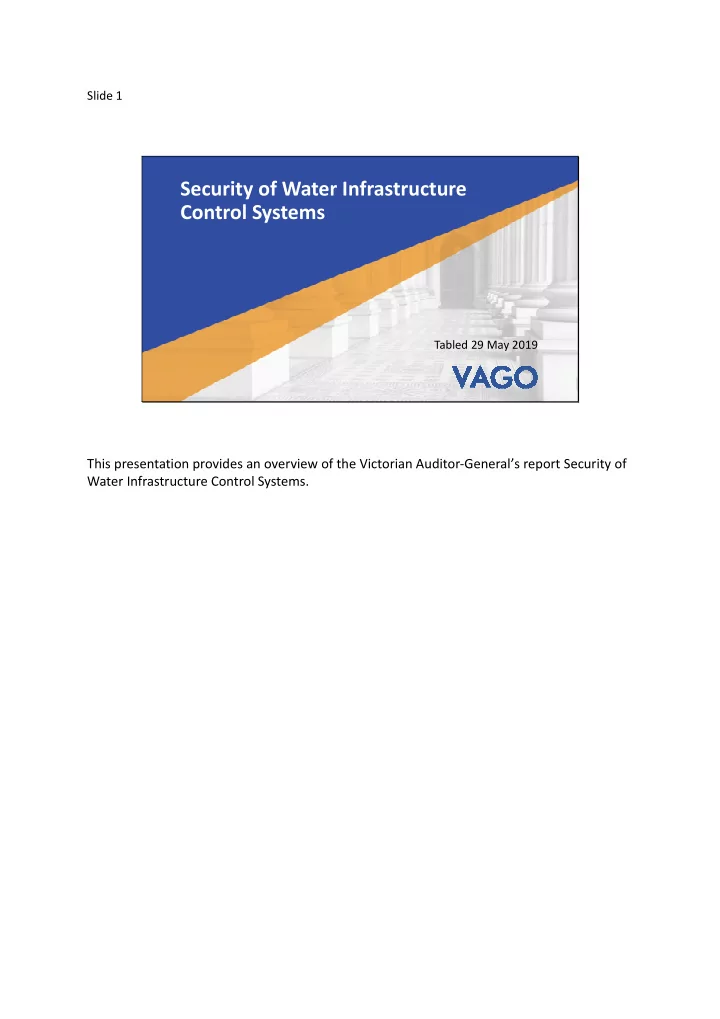

Slide 1 Security of Water Infrastructure Control Systems Tabled 29 May 2019 This presentation provides an overview of the Victorian Auditor‐General’s report Security of Water Infrastructure Control Systems.
Slide 2 Overview Water providers are responsible for water and sewerage services Control systems operate and Treatment plants and water pumping monitor infrastructure assets stations 2010 audit found weaknesses This audit focuses on these systems in in control system security the water sector 2 Water providers are responsible for supplying water and sewerage services to Victorians. Water providers rely on control systems to operate and monitor a portion of their infrastructure assets such as treatment plants and water pumping stations. Our 2010 audit, Security of Infrastructure Control Systems for Water and Transport, noted significant weaknesses in the security of control systems of water and train operators. This audit focuses on control systems in the water sector.
Slide 3 Water infrastructure control systems Historically isolated Now connected → increasingly the target of cyber a�acks Significant risks Several high profile cyberattacks globally 3 3 Historically, control systems were isolated from each other, corporate systems and the internet. Now, they are connected making them increasingly the target of cyberattack. If successful this poses significant risks to public health and safety, the environment, and the business operations of the entities that use them. There have been several high profile cyberattacks globally on these systems.
Slide 4 Who we looked at • Four water providers: • Melbourne Water • Barwon Water • Yarra Valley Water • Victorian Desalination Plant • Department of Environment, Land, Water and Planning • Emergency Management Victoria 4 We audited four water providers: Melbourne Water, Barwon Water, Yarra Valley Water and the Victorian Desalination Plant. We also included the Department of Environment, Land, Water and Planning because it has overall responsibility for the state’s water and sewerage services, and water sector resilience. And we also included Emergency Management Victoria, which leads and coordinates Victoria’s emergency management
Slide 5 Focus To determine whether control systems in the water sector are secure We looked at: • governance arrangements • control system vulnerabilities 5 The focus of this audit was to determine whether control systems in the water sector are secure. We examined the governance arrangements over these systems. We also undertook a security architecture review, vulnerability assessment and a physical security inspection of a sample of sites.
Slide 6 What we found Lack of a strategic approach to managing cybersecurity Exposure of control systems to risk of a successful cyberattack Need to significantly strengthen control system security 6 We found that water providers lack a strategic approach to managing cybersecurity risks that integrates their corporate and control system environments and aligns to leading industry security standards for control systems. This exposes control systems to the risk of a successful cyberattack, particularly by a trusted insider, or an intruder breaching physical security and gaining unauthorised access. While the audited water providers have actively improved the security of their corporate systems against cyberattacks, evolving threats requires water providers to now increase their focus on assessing and significantly strengthening their control system security.
Slide 7 Security vulnerability testing found a lack of: Compliance Adherence Security and with security to user Security Physical system and system management monitoring security hardening patches practices 7 Our vulnerability assessment found water providers did not: • consistently apply system and security updates • comply with or enforce user management practices • monitor systems to identify cyberattacks • maintain adequate physical security • minimise opportunities for unauthorised access
Slide 8 Governance arrangements Need to approach security holistically Security not based on leading industry standards Policies and procedures do not adequately address control systems Activities are reactive rather than coordinated 8 Our review of governance arrangements found water providers need to take a more holistic approach to security. Currently, water providers have not designed security based on leading industry standards. Additionally, their security policies and procedures do not adequately address control systems, and security activities are reactive rather than coordinated.
Slide 9 Rebalancing focus Significantly focused on corporate system security Security approach needs to consider both corporate and control systems Clarify roles and responsibilities 9 Water providers need to rebalance their security focus. They have invested significantly in securing corporate systems. However, control systems that deliver critical services are equally as important. Current security activities have not generally extended to their control systems. Water providers have not clearly defined roles and responsibilities for the security of these systems.
Slide 10 Assessing security risks Control system assets vulnerabilities and security risks not understood Essential to inform security decisions 10 Water providers’ approach to security is not based on a thorough understanding of control system assets, associated vulnerabilities and security risks. This information is essential for making informed decisions about the appropriate level of security for each part of the business.
Slide 11 Recommendations 4 Recommendations for audited water providers • Adopt a holistic approach to cybersecurity • Clarify roles and responsibilities for control system security governance • Identify control system asset security vulnerabilities and risks • Design, build and maintain a security architecture based on risk and leading industry security standards for control systems 11 We made four recommendations to the water providers to develop a more holistic approach to cybersecurity, based on leading industry security standards.
Slide 12 For further information, please view the full report on our website: www.audit.vic.gov.au 12 For further information, please see the full report on our website, at www.audit.vic.gov.au.
Recommend
More recommend